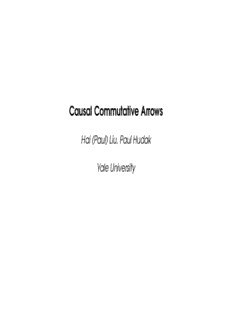
Causal Commutative Arrows - theV.net PDF
Preview Causal Commutative Arrows - theV.net
Causal Commutative Arrows Hai (Paul) Liu, Paul Hudak Yale University Outline Arrows and FRP ◮ • Introduction • Arrow Laws and Properties Causal Commutative Arrows (CCA) ◮ • Syntax, types and Semantics • Implementation by Mealy Machine Optimization by Normalization ◮ • Causal Commutative Normal Form (CCNF) • Benchmarks Contributions A minimal language that captures the essence of causal ◮ computation. Two additional laws that lead to normal forms. ◮ Substantial performance gain via optimization by normalization. ◮ Exponential Example A math definition of the exponential function: t e(t) = 1 + e(t) · dt Z 0 Yampa program using the Arrow Syntax: exp = proc () → do rec let e = 1 + i i ← integral −≺ e returnA −≺ e Functional Reactive Programming Computations about time-varying quantities. Signal α ≈ Time → α Yampa (Hudak, et. al. 2002) is a version of FRP using the Arrow framework (Hughes, 2000). Arrows provide: Abstract computation over signals. ◮ SF α β ≈ Signal α → Signal β A minimum set of wiring combinators. ◮ Mathematics root in category theory. ◮ What is Arrow A generalization of Monads. In Haskell: class Arrow a where arr :: (b → c) → a b c (>>>) :: a b c → a c d → a b d first :: a b c → a (b,d) (c,d) Support both sequential and parallel composition: second :: (Arrow a) ⇒ a b c → a (d,b) (d,c) second f = arr swap >>> first f >>> arr swap where swap (a, b) = (b, a) (***) :: (Arrow a) ⇒ a b c → a b’ c’ → a (b, b’) (c, c’) f *** g = first f >>> second g Arrows in Picture (a) arr f (b) f >>> g (c) first f (d) f *** g (e) loop f To model recursion, Paterson (2001) introduced ArrowLoop: class Arrow a ⇒ ArrowLoop a where loop :: a (b,d) (c,d) → a b c Arrows and FRP Why do we need Arrows? ◮ Modular, both input and output are explicit. ◮ Eliminates a form of time and space leak (Liu and Hudak, 2007). ◮ Abstract, with properties enforced by arrow laws. Why do we need abstraction? ◮ Think at the high level. Focus on the essence. ◮ Disciplines bring interesting properties and useful results. Arrow Laws ≫ left identity arr id f = f ≫ right identity f arr id = f ≫ ≫ ≫ ≫ associativity (f g) h = f (g h) ≫ composition arr (g · f) = arr f arr g extension first (arr f) = arr(f × id) ≫ ≫ functor first (f g) = first f first g ≫ ≫ exchange first f arr (id × g) = arr (id × g) first f ≫ ≫ unit first f arr fst = arr fst f ≫ ≫ association first (firstf) arr assoc = arr assoc firstf where assoc ((a, b), c) = (a, (b, c)) Arrow Loop Laws ≫ ≫ left tightening loop (first h f) = h loop f ≫ ≫ right tightening loop (f first h) = loop f h ≫ ≫ sliding loop (f arr (id × k)) = loop (arr (id × k) f) −1 ≫ ≫ vanishing loop (loop f) = loop (arr assoc f arr assoc) ≫ ≫ −1 superposing second (loop f) = loop (arr assoc second f arr assoc ) extension loop (arr f) = arr(trace f) where trace f b = let (c, d) = f (b, d) in c
Description: